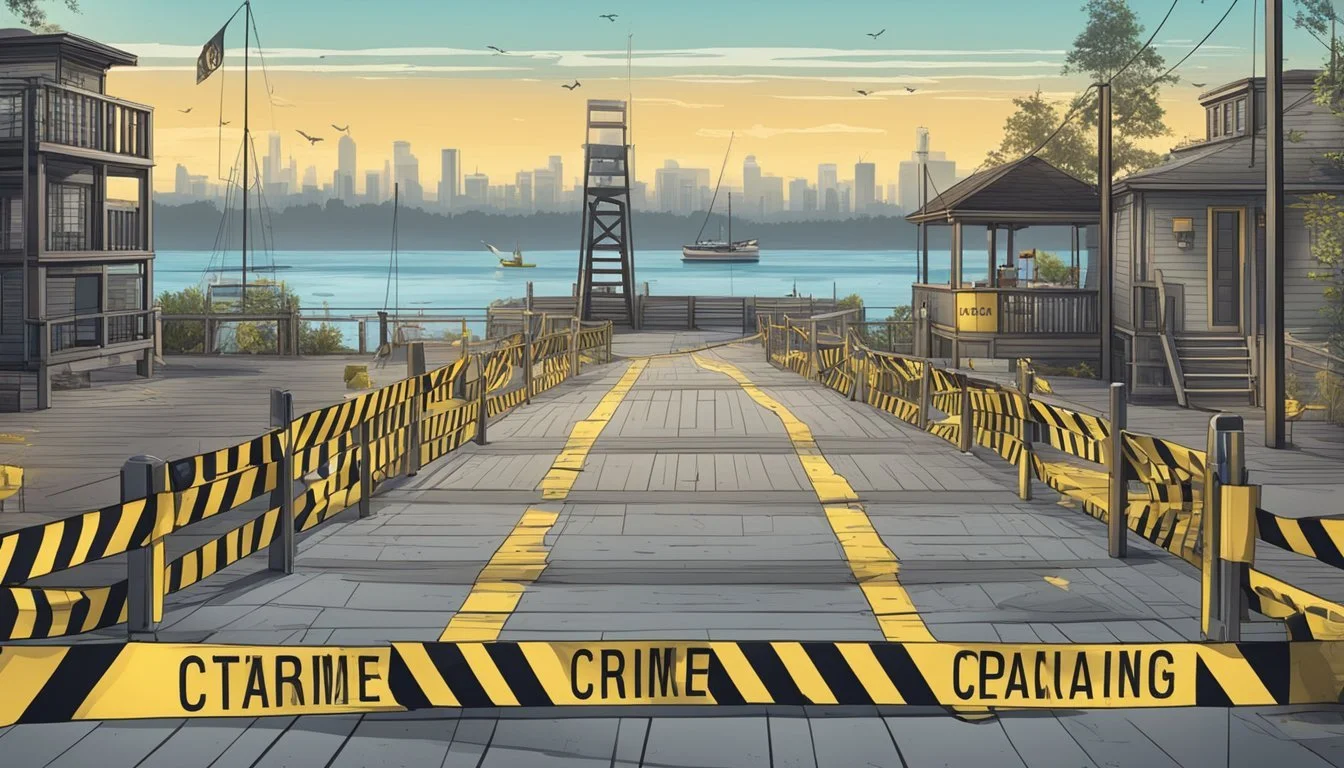Jersey Shore Killer: Robert Zarinsky's Boardwalk of Blood
Uncovering a Serial Murderer's Reign of Terror
Robert Zarinsky, known as the Jersey Shore Killer, terrorized New Jersey during the 1960s and 1970s. His reign of terror left a trail of unsolved murders, primarily targeting young women and girls along the coastal areas. Zarinsky's crimes spanned decades, with his first suspected murder occurring in 1958 and continuing until his arrest in 1975.
Born on September 2, 1940, Zarinsky grew up in New Jersey and eventually became one of the state's most notorious serial killers. His criminal activities sent shockwaves through local communities, leaving families devastated and investigators puzzled for years. The Jersey Shore, once a place of summer fun and relaxation, became tainted by the shadow of Zarinsky's brutal acts.
Zarinsky's case gained renewed attention in recent years as advances in forensic technology helped solve some of the cold cases linked to him. Despite being convicted of only one murder, he remained a prime suspect in several other unsolved killings. Zarinsky's story continues to captivate true crime enthusiasts and serves as a chilling reminder of the dark chapter in New Jersey's history.
Robert Zarinsky: The Early Years
Robert Zarinsky's upbringing and initial criminal activities laid the foundation for his later notoriety as the Jersey Shore Killer. His troubled youth in New Jersey and early brushes with the law foreshadowed the violent path he would eventually take.
Background and Upbringing
Robert Zarinsky was born on September 2, 1940, in Rahway, New Jersey. He grew up in a working-class family in the industrial town. Zarinsky's childhood was marked by instability and conflict. His father struggled with alcohol abuse, creating a tense home environment.
As a youth, Zarinsky displayed troubling behavior. He was known for his quick temper and tendency to bully other children. Teachers noted his disruptive actions in school. Despite these issues, Zarinsky managed to graduate from Rahway High School in 1958.
Emergence of Criminal Behavior
Zarinsky's criminal activities began in his teenage years. He faced several arrests for minor offenses like vandalism and petty theft. By his early 20s, his crimes escalated in severity.
In 1961, Zarinsky was arrested for breaking and entering. This marked his first significant encounter with the justice system. Over the next few years, he accumulated a rap sheet that included:
Assault
Weapons possession
Burglary
Law enforcement in Rahway became increasingly familiar with Zarinsky. His volatile behavior and growing criminal record raised concerns. However, the true extent of his violent tendencies would not become apparent until later in the 1960s, when he began targeting teenage girls in the Jersey Shore area.
Notorious Murders and Abductions
Robert Zarinsky's reign of terror left an indelible mark on New Jersey's shore communities. His victims were predominantly young women and girls, whose lives were tragically cut short.
The Disappearance of Rosemary Calandriello
On August 25, 1969, 17-year-old Rosemary Calandriello vanished from Atlantic Highlands. Witnesses reported seeing her enter a car driven by Zarinsky. Despite extensive searches, her body was never found.
Zarinsky was convicted of Calandriello's murder in 1975, marking a significant breakthrough in the case. The conviction relied on circumstantial evidence and eyewitness testimony.
This case highlighted the challenges faced by investigators in solving crimes with limited physical evidence.
Brutal Ends: Jane Durrua and Others
Jane Durrua, 13, disappeared on November 4, 1968, in Keansburg. Her battered body was found days later. Zarinsky was a prime suspect but wasn't charged until decades later.
Other victims linked to Zarinsky include:
Linda Balabanow, 17, found dead in 1969
Joanne Delardo, 15, and Doreen Carlucci, 14, both murdered in 1974
These cases remained unsolved for years, tormenting victims' families. Advances in DNA technology eventually helped connect Zarinsky to some of these crimes, bringing a measure of closure to grieving loved ones.
The Hunt and Capture of Zarinsky
Robert Zarinsky eluded authorities for years as he terrorized the Jersey Shore. His capture and conviction marked the end of a long, frustrating pursuit by law enforcement agencies across New Jersey.
Law Enforcement Pursuit
The Monmouth County Prosecutor's Office led the investigation into Zarinsky's crimes. Detectives meticulously combed through evidence from multiple murder cases, searching for connections. They interviewed witnesses and followed countless leads.
Zarinsky's name surfaced repeatedly during the investigation. His violent tendencies and criminal history made him a prime suspect. However, solid evidence remained elusive for years.
The 1958 murder of a Rahway police officer added another layer to the case. Investigators suspected Zarinsky's involvement but lacked proof to charge him at the time.
Inevitable Capture and Trial
In 1975, breakthrough evidence finally linked Zarinsky to the murder of 17-year-old Rosemary Calandriello. Police arrested him at his home in Linden, New Jersey.
Zarinsky's trial began in August 1975. Prosecutors presented a strong case, including eyewitness testimony placing him with the victim. The jury found Zarinsky guilty of murder.
The judge sentenced Zarinsky to life in prison. This conviction marked a significant victory for law enforcement and brought some closure to victims' families.
Zarinsky continued to be a suspect in other unsolved murders. Investigators worked tirelessly to build cases against him for additional crimes.
Legal Proceedings and Sentencing
Robert Zarinsky faced multiple legal battles for his crimes. His trial and conviction led to a life sentence, while civil cases sought compensation for victims' families.
Trial and Conviction Details
Robert Zarinsky's trial for the murder of Rosemary Calandriello began in 1975. Prosecutors presented evidence linking him to the 17-year-old's disappearance in 1969. The jury found Zarinsky guilty of first-degree murder.
The judge sentenced Zarinsky to life in prison. This conviction marked a significant breakthrough in the case, as Calandriello's body was never found.
Zarinsky maintained his innocence throughout the proceedings. He attempted several appeals, but the New Jersey Appellate Court upheld his conviction.
Civil Cases and Compensation
In addition to criminal charges, Zarinsky faced civil lawsuits from victims' families. The family of Charles Bernoskie, a police officer killed in 1958, sued Zarinsky in 1999.
A civil trial resulted in a $9.5 million judgment against Zarinsky. The jury found him liable for Bernoskie's death, despite his acquittal in a criminal trial.
To satisfy the judgment, authorities seized Zarinsky's assets. This included a mutual fund account worth over $150,000. The Bernoskie family received this money as partial compensation for their loss.
Scientific Breakthroughs and DNA Evidence
DNA analysis revolutionized cold case investigations, providing crucial links between suspects and decades-old crimes. For Robert Zarinsky, these advancements proved pivotal in connecting him to previously unsolved murders along the Jersey Shore.
Advancements in Forensic Technology
Forensic science made significant strides in the decades following Zarinsky's initial crimes. Improved DNA extraction techniques allowed investigators to obtain genetic profiles from smaller, degraded samples. Polymerase chain reaction (PCR) amplification enhanced the ability to analyze minute traces of biological evidence.
Enhanced database systems, like CODIS (Combined DNA Index System), enabled rapid comparisons of DNA profiles across multiple jurisdictions. This technology proved especially valuable in cold cases, where traditional investigative methods had reached dead ends.
Innovations in touch DNA analysis allowed scientists to recover genetic material from items merely handled by perpetrators, expanding the types of evidence that could yield useful results.
Linking Zarinsky to Unsolved Cases
In 2016, DNA evidence linked Robert Zarinsky to the 1965 murder of Mary Agnes Klinsky in Hazlet, New Jersey. The Monmouth County Prosecutor's Office announced that genetic material recovered from the crime scene matched Zarinsky's profile.
This breakthrough came decades after the initial investigation, demonstrating the power of preserved evidence. Authorities had retained biological samples from Klinsky's case, allowing for modern analysis when technology caught up.
The DNA match provided closure to Klinsky's family and solidified Zarinsky's status as a serial killer. It also prompted reviews of other unsolved cases in the region, as investigators sought potential connections to Zarinsky's known activities.
Zarinsky's Imprisonment and Death
Robert Zarinsky spent over three decades in prison following his conviction for murder. His life behind bars ended with his death from a chronic lung condition in 2008.
Life Behind Bars
Zarinsky began serving his life sentence in 1975 after being convicted of murdering Rosemary Calandriello. He was incarcerated at various New Jersey state prisons over the years. In later life, Zarinsky was housed at South Woods State Prison in Bridgeton.
Despite being imprisoned, Zarinsky continued to make headlines. He faced additional murder charges and civil lawsuits related to other suspected killings. Zarinsky maintained his innocence and fought legal battles from behind bars.
Prison records indicate Zarinsky was a challenging inmate who had conflicts with staff and other prisoners. He spent time in solitary confinement for rules violations.
The Cause of Death: Pulmonary Fibrosis
On November 28, 2008, Robert Zarinsky died at age 68 in the hospice unit of South Woods State Prison. The official cause of death was pulmonary fibrosis, a progressive lung disease that causes scarring of lung tissue.
Zarinsky had been battling declining health in his final years. He appeared in court on a gurney, requiring oxygen, just months before his death. The chronic nature of pulmonary fibrosis meant Zarinsky likely suffered breathing difficulties for some time.
His death marked the end of one of New Jersey's most notorious criminal cases. Zarinsky went to his grave without confessing to or being convicted of additional murders beyond the Calandriello case.
The Aftermath and Impact on Society
Robert Zarinsky's crimes left deep scars on the Jersey Shore community and the families of his victims. His actions sparked fear and changed the way people viewed safety in the area for years to come.
Impact on the Victims' Families
The families of Zarinsky's victims endured decades of anguish and uncertainty. Many cases remained unsolved for years, leaving loved ones without closure. The pain of loss was compounded by the frustration of not knowing what had happened to their daughters and sisters.
Some families never gave up hope for answers. They continued to press law enforcement for information and kept the memory of their loved ones alive. The eventual solving of some cases through DNA evidence brought a measure of relief, but also reopened old wounds.
The emotional toll on these families was immense. Many struggled with grief, anger, and a sense of injustice that persisted long after Zarinsky's imprisonment.
Jersey Shore Community and Public Reaction
Zarinsky's crimes shattered the sense of safety once enjoyed by Jersey Shore residents. Parents became more protective of their children, especially young girls. The carefree atmosphere of the boardwalk was tainted by fear and suspicion.
Public outrage grew as more details of Zarinsky's criminal history came to light. Community meetings were held to discuss safety measures. Neighborhood watch programs expanded, and local law enforcement increased patrols in areas frequented by young people.
The media coverage of Zarinsky's crimes and trials kept the public on edge for years. His name became synonymous with evil in the region, a cautionary tale passed down to younger generations.
The lasting impact of Zarinsky's actions can still be felt in the Jersey Shore area today. His crimes serve as a grim reminder of the importance of community vigilance and support for victims' families.
Reflections on the Case and Legacy
Robert Zarinsky's crimes left an indelible mark on New Jersey communities. His case continues to impact law enforcement practices and public perceptions of safety decades later.
The Legacy of a Suspected Serial Killer
Robert Zarinsky's crimes shocked the Jersey Shore in the 1960s and 1970s. He was convicted of murdering 17-year-old Rosemary Calandriello in 1969, but suspicions lingered about his involvement in other unsolved cases. Zarinsky's actions instilled fear in local communities and prompted increased vigilance.
The investigation into Zarinsky's crimes spanned decades. Law enforcement agencies dedicated significant resources to solving cold cases potentially linked to him. This persistence highlighted the importance of long-term commitment in resolving complex criminal investigations.
Zarinsky's case also influenced public awareness about personal safety, especially for young women. It served as a stark reminder of the potential dangers lurking in seemingly safe environments.
Continued Investigations and Parole Attempts
Even after Zarinsky's conviction, investigations into other unsolved murders continued. Authorities explored potential connections to at least four additional cases, including the 1958 killing of a Rahway police officer.
Zarinsky maintained his innocence throughout his incarceration. He made multiple attempts to secure parole, all of which were denied. These denials reflected the severity of his crimes and the ongoing concerns about public safety.
In 2008, DNA evidence linked Zarinsky to the 1965 murder of Mary Agnes Klinsky. This breakthrough provided closure for the victim's family after 50 years of uncertainty. It also demonstrated the value of preserving evidence and utilizing advancing forensic technologies in cold cases.






